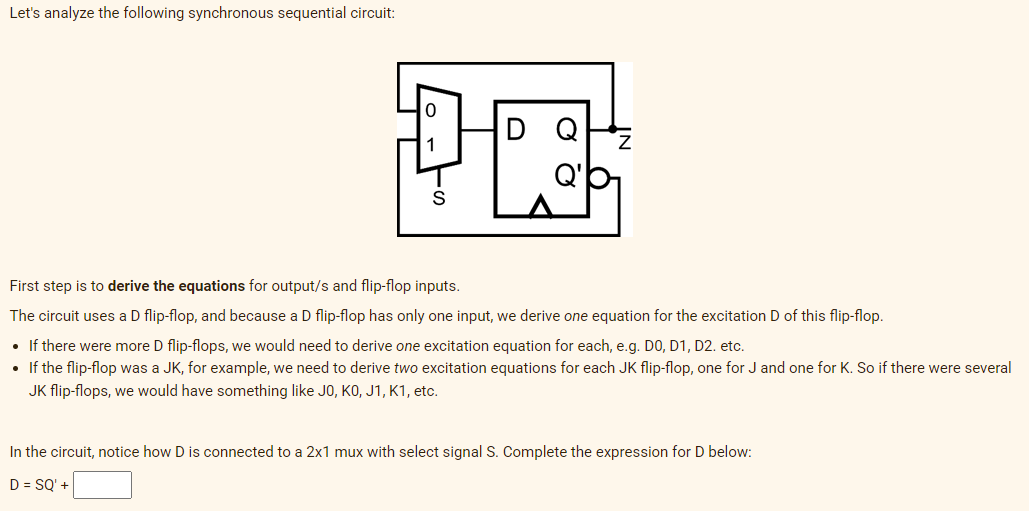et's analyze the following synchronous sequential circuit: Q S rst step is to derive the equations for output/s and flip-flop inputs. he circuit uses a D flip-flop, and because a D flip-flop has only one input, we derive one equation for the excitation D of this flip-flop. If there were more D flip-flops, we would need to derive one excitation equation for each, e.g. DO, D1, D2. etc. If the flip-flop was a JK, for example, we need to derive two excitation equations for each JK flip-flop, one for J and one for K. So if there were se JK flip-flops, we would have something like JO, KO, J1, K1, etc. the circuit, notice how D is connected to a 2x1 mux with select signal S. Complete the expression for D below: = SQ't
et's analyze the following synchronous sequential circuit: Q S rst step is to derive the equations for output/s and flip-flop inputs. he circuit uses a D flip-flop, and because a D flip-flop has only one input, we derive one equation for the excitation D of this flip-flop. If there were more D flip-flops, we would need to derive one excitation equation for each, e.g. DO, D1, D2. etc. If the flip-flop was a JK, for example, we need to derive two excitation equations for each JK flip-flop, one for J and one for K. So if there were se JK flip-flops, we would have something like JO, KO, J1, K1, etc. the circuit, notice how D is connected to a 2x1 mux with select signal S. Complete the expression for D below: = SQ't
Introductory Circuit Analysis (13th Edition)
13th Edition
ISBN:9780133923605
Author:Robert L. Boylestad
Publisher:Robert L. Boylestad
Chapter1: Introduction
Section: Chapter Questions
Problem 1P: Visit your local library (at school or home) and describe the extent to which it provides literature...
Related questions
Question

Transcribed Image Text:Let's analyze the following synchronous sequential circuit:
First step is to derive the equations for output/s and flip-flop inputs.
The circuit uses a D flip-flop, and because a D flip-flop has only one input, we derive one equation for the excitation D of this flip-flop.
• If there were more D flip-flops, we would need to derive one excitation equation for each, e.g. DO, D1, D2. etc.
• If the flip-flop was a JK, for example, we need to derive two excitation equations for each JK flip-flop, one for J and one for K. So if there were several
JK flip-flops, we would have something like J0, KO, J1, K1, etc.
In the circuit, notice how D is connected to a 2x1 mux with select signal S. Complete the expression for D below:
D = SQ' +
Expert Solution
This question has been solved!
Explore an expertly crafted, step-by-step solution for a thorough understanding of key concepts.
Step by step
Solved in 2 steps

Knowledge Booster
Learn more about
Need a deep-dive on the concept behind this application? Look no further. Learn more about this topic, electrical-engineering and related others by exploring similar questions and additional content below.Recommended textbooks for you

Introductory Circuit Analysis (13th Edition)
Electrical Engineering
ISBN:
9780133923605
Author:
Robert L. Boylestad
Publisher:
PEARSON

Delmar's Standard Textbook Of Electricity
Electrical Engineering
ISBN:
9781337900348
Author:
Stephen L. Herman
Publisher:
Cengage Learning

Programmable Logic Controllers
Electrical Engineering
ISBN:
9780073373843
Author:
Frank D. Petruzella
Publisher:
McGraw-Hill Education

Introductory Circuit Analysis (13th Edition)
Electrical Engineering
ISBN:
9780133923605
Author:
Robert L. Boylestad
Publisher:
PEARSON

Delmar's Standard Textbook Of Electricity
Electrical Engineering
ISBN:
9781337900348
Author:
Stephen L. Herman
Publisher:
Cengage Learning

Programmable Logic Controllers
Electrical Engineering
ISBN:
9780073373843
Author:
Frank D. Petruzella
Publisher:
McGraw-Hill Education

Fundamentals of Electric Circuits
Electrical Engineering
ISBN:
9780078028229
Author:
Charles K Alexander, Matthew Sadiku
Publisher:
McGraw-Hill Education

Electric Circuits. (11th Edition)
Electrical Engineering
ISBN:
9780134746968
Author:
James W. Nilsson, Susan Riedel
Publisher:
PEARSON

Engineering Electromagnetics
Electrical Engineering
ISBN:
9780078028151
Author:
Hayt, William H. (william Hart), Jr, BUCK, John A.
Publisher:
Mcgraw-hill Education,